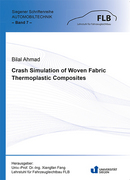Bilal Ahmad: Crash Simulation of Woven Fabric Thermoplastic Composites (Diss. 2021), Reihe AUTOMOBILTECHNIK, Bd. 7)
Fiber composite materials are frequently being used in automotive industry to meet the growing demand for fuel efficient passenger cars. Woven fabric thermoplastic composites materials provide high stiffness-to-weight, strength-to-weight and energy absorption-to-weight ratio at affordable mass production cost.
To use these materials in structural components of passenger cars, the crashworthiness requirements must be met. To fulfill the crashworthiness requirements, dynamic FEM simulations are carried out as part of the product development process. However, the composite material behavior under dynamics loads is not fully understood. Furthermore, the state-of-the-art material models fail to predict the crash behavior of woven fabric composite material accurately which leads to under-utilization of the weight-saving-potential of these materials.
The goal of this work was to develop an improved material model for the dynamics simulation of woven fabric thermoplastic composites. The material model must be independent of non-physical parameters and all parameters could be determined experimentally.
In the framework of this work, the mechanical material properties were measured experimentally. The test data was used to identify discrepancies in state-of-the-art continuum damage mechanics material models. The in-plane shear damage behavior was improved and effects of tensile and compression strain on the shear behavior were quantified. High-speed test data was used to incorporate the strain rate-dependency in material model. The improved material model was implemented as user-material subroutine and simulation results were validated with component level drop tower crash tests.
The potential for further improvements was identified by proposing the method to implement the measured size effect on the strength of materials. Stress-strain transformation was used to determine the failure points under multiaxial stress state. Finally, the viability of cohesive zone modeling approach was investigated to model the quasi-static axial crushing.
Bilal Ahmad
Crash Simulation of Woven Fabric Thermoplastic Composites
Siegener Schriftenreihe Automobiltechnik (2021), hrsg. von Xiangfan Fang, Band 7
Siegen: universi 2021, 186 S., farb. Abb.
ISSN 2568-0374
ISBN 978-3-96182-108-2
Preis: 19,- Euro
Onlineversion auf dem OPUS-Server der Universitätsbibliothek




